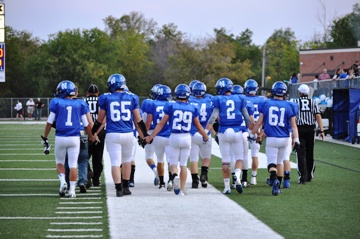Limiting the amount of full-contact tackling during high school football practices can have a big impact on reducing the number of concussions among players, new research finds.
A University of Wisconsin-Madison research paper presented at the American Academy of Pediatrics (AAP) National Conference & Exhibition in Washington, DC, examined sports-related concussion rates among Wisconsin high school football players after the state's interscholastic athletic association mandated new limits on the amount and duration of full-contact activities during team practices.
The rule, which first went into effect for the 2014 season, prohibits full contact during the first week of practice, limits full contact to 75 minutes per week during week 2, and caps it at 60 minutes thereafter. Full contact is defined as drills or game situations when full tackles are made at a competitive pace and players are taken to the ground.
Findings show that the rate of sports-related concussions sustained during high school football practice was more than twice as high in the two seasons prior to the rule change as compared to the 2014 season, said University of Wisconsin-Madison senior scientist Timothy A. McGuine, PhD, ATC.
"This
study confirms what athletic trainers who work with high school football
programs have long believed regarding the association of full contact drills or
practices and the likelihood a player will sustain a concussion," Dr. McGuine
said. "This is probably also true for other football injuries such as sprains,
fractures and dislocations."
The study used data from the Wisconsin Interscholastic Sports Injury Research Network, which has recruited and enrolled more than 16,000 adolescent athletes from 103 high schools and sport venues across Wisconsin to serve as subjects for cross sectional, cohort and randomized control trials.
Limits on full-contact practices: a 'no-brainer'
The study's findings suggest that limiting full-contact high school football practices may be a no-brainer, Dr. McGuine said. "Educating high school coaches to limit the amount of full contact would be an effective and economical way to help protect students from head injuries," he said.
The results of the Wisconsin study are supported by preliminary data from the High School RIO injury surveillance system suggesting that the limits on full-contact practices in Texas implemented before the 2013 season had resulted in a statistically significant decrease in concussion rates during practices, and that similar results were seen in Arizona, Maryland, and Alabama after comparable changes were made in 2013 to practice rules in those states.
A growing number of state high school athletic associations have implemented, in whole or in part, recommendations issued in 2014 by the National Federation of State High School Associations (NFHS) that members adopt limits on full-contact practices in high school football.
Limits on full-contact practices have also been implemented at all levels of football, including professional (National Football League), college (Ivy League and Pac-12), and youth football (Pop Warner),
Sources:
American Academy of Pediatrics
Research paper, "Effect of New Rule Limiting Full Contact Practice on Incidence of Sport Related Concussion in High School Football Players." McGuine TA, Hetzel S, Brooks MA. Presented at American Academy of Pediatrics National Conference and Exhibition. October 24-27, 2015, Washington, D.C.







